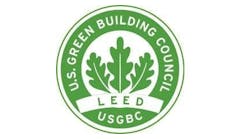For fast-moving facilities, flooring needs to be just right to withstand the rigor of daily traffic but also contribute to the aesthetics of a modern workplace. In the past, facilities managers have struggled to find a flooring option that does both of these, but the emergence of high-quality resilient vinyl tiles has provided more options. Is a vinyl flooring solution right for your facility?
Leveraging Design with Durability
Vinyl flooring has improved considerably in terms of design opportunities. Luxury vinyl tile (LVT) is one such product that has developed as a durable flooring replacement for hardwood and other natural materials. Able to mimic wood and stone, LVT comes in tiles or planks and can provide an aesthetic change-up to some commercial and healthcare facilities that would otherwise be unable to make use of wood flooring.
Beyond just aesthetics, resilient vinyl flooring can help with acoustical design compared to other hard flooring surfaces, as many options can reduce the impact of noise, according to a recent study. When it comes to acoustics, vinyl flooring might not perform as well as carpet and other soft flooring options, but it is more flexible for facilities.
Vinyl flooring typically comes in two design types: printed and inlaid. According to the World Floor Covering Association (WFCA), printed vinyl patterns are printed using a paper top coat placed on a vinyl surface. To provide a wear layer, it is covered with multiple layers of clear vinyl or urethane. Compared to inlaid vinyl, it is conventionally more affordable but less durable. LVT is a higher quality printed vinyl tile with natural materials being photographed and printed into the tile, and they often come as planks.
The production of inlaid vinyl patterns involves placing vinyl granules on the backing and forcing them up to the wear surface, explains WFCA. This process makes them heavier and more durable because it is composed of vinyl all the way through the floor’s thickness.
The best quality LVT options come printed with multiple layers of resilient polymer. These and any other kind of high quality vinyl flooring will provide strong durability, so they are a good fit in facilities with a large number of building occupants. They can adequately handle high foot traffic for a long period of time and resist chipping, scuffing and other symptoms of wear.
For all vinyl flooring options, the wear layer is a critical to the long-term viability of the floor surface. WFCA identifies three main types:
- Vinyl no-wax is a clear top coating. It is the least durable and requires polishing on a regular basis to maintain its luster.
- Urethane-coated finishes are more durable and resist stains and wear. They do not need to be polished.
- Enhanced coatings used with urethane finishes are the most durable. Flooring that has an additional aluminum oxide coating, for instance, is more durable than urethane coatings alone.
Identifying the best quality options for your budget will improve the long-term viability of your flooring and reduce headaches.
Maintaining Vinyl Flooring
One drawback to vinyl flooring is that it requires different maintenance, which can add up in costs. The aforementioned study found that the cost of equipment for resilient flooring including vinyl and other hard flooring was 2.5 times more expensive than for soft flooring.
“The median costs of equipment needed for floor care of hard and resilient surfaces, such as scrubbing and buffing machines, were more expensive than the median costs for the vacuum cleaners, dry foam soil extractors and hot water extractor required to clean and maintain soft flooring,” the study explains. Of course, some higher quality vinyl flooring options like LVT will reduce that cost because they require less maintenance than the average vinyl flooring.
Most vinyl flooring is moisture-resistant, but you will need to make sure that water doesn’t sit on the flooring, as its traction and resistance aren’t enough in many instances to prevent slips and falls. Like any type of flooring, resilient vinyl requires an active approach to avoid liability issues.
Justin Feit [email protected] is Associate Editor of BUILDINGS.

